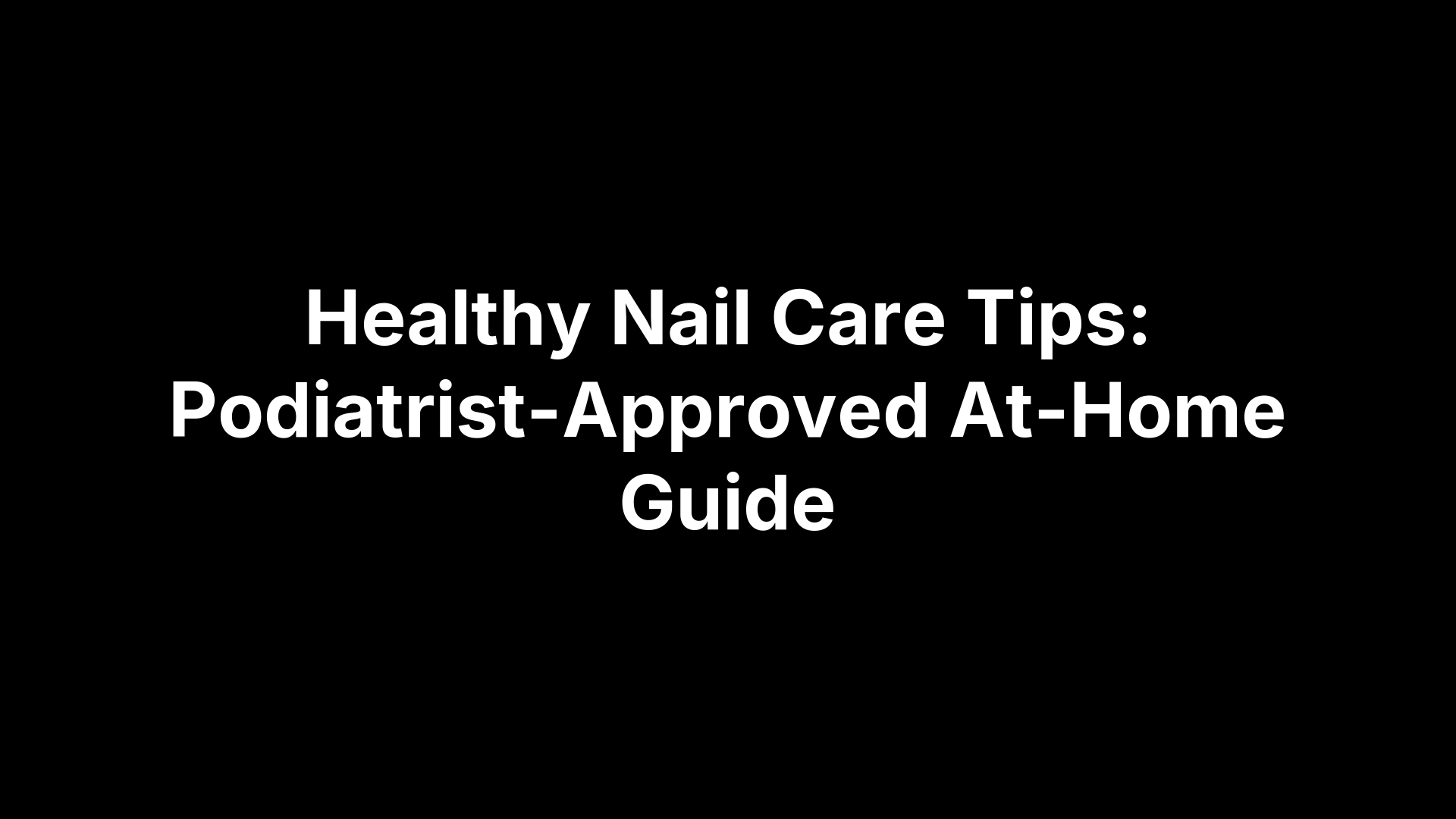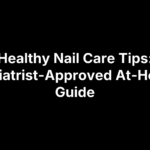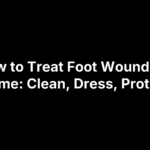Hearing the word “amputation” when you have a nonhealing foot or ankle wound is frightening. Diabetes, peripheral artery disease, neuropathy, and infection can turn a small sore into a limb‑threatening emergency faster than most people expect. When pain at rest, blackened toes, drainage, or a wound that won’t close appear, time matters. The challenge is knowing where to go and how to get coordinated care quickly enough to save function—and often, to save life.
A well-run limb salvage program brings the right specialists to you, fast. In one place, you should get same‑week vascular testing and revascularization when needed, advanced wound debridement and dressings, culture‑guided antibiotics, offloading, and rehab support—guided by clear protocols and tracked outcomes. Choosing that program—and getting on the schedule without delays—can make the difference between healing and an avoidable amputation.
This practical guide shows you how to choose a limb salvage program and start treatment with confidence. You’ll learn what these programs do, urgent red flags, the essential capabilities to look for, how teams coordinate, what outcomes and quality measures to expect, and how facilities, technology, insurance, and scheduling affect your care. We’ll outline treatments and first-visit prep, build a plan for blood flow, wound care, infection, and offloading, cover risk‑factor optimization and home care, discuss when amputation is safer, key questions to ask, and how to get started in Central Virginia.
Step 1. Know what a limb salvage program is and who it helps
A limb salvage program is not a single specialist—it’s a coordinated, protocol‑driven team that works to prevent amputation. Backed by evidence and societal guidelines, these programs combine rapid vascular assessment and revascularization, advanced wound care and debridement, culture‑guided antibiotics, offloading, and risk‑factor optimization, with outcomes tracked to steadily improve care.
Who benefits most from a limb salvage program
- Chronic limb‑threatening ischemia (CLTI): Peripheral artery disease with rest pain, nonhealing ulcers (often >2 weeks), or gangrene.
- Diabetic foot disease: Ulcers, infections, or deformities complicated by neuropathy and poor circulation.
- Complex infections: Deep tissue or bone infections needing surgical cultures and targeted antibiotics.
- Recurrent or nonhealing wounds: Especially after prior partial foot amputation or repeated breakdown.
- High‑risk medical profiles: Diabetes, kidney disease, smoking, or cardiovascular disease that slow healing.
- Trauma or surgical wounds at risk of limb loss: Injuries or reconstructions with compromised blood flow.
What sets these programs apart is the multidisciplinary bench—typically vascular surgery/intervention, podiatry, wound care nursing, infectious diseases, endocrinology, rehab, and orthotics—working from shared pathways. This approach has been associated with lower major amputation rates and faster, more organized care. Next, learn the red flags that signal you need urgent evaluation now.
Step 2. Spot red flags that need urgent evaluation
When blood flow is low or infection takes hold, hours and days matter. If you notice any of the red flags below, seek urgent evaluation with a limb salvage program. These signs often indicate chronic limb‑threatening ischemia (CLTI), serious infection, or both—situations that benefit from rapid, protocol‑driven care and coordinated revascularization, wound management, antibiotics, and offloading.
- Pain at rest or night pain: Foot or toe pain without walking, especially if new or worsening.
- Wound not healing >2 weeks: Any ulcer that stalls or enlarges despite basic care.
- Blackened or discolored toes/skin: Suspected gangrene or new tissue loss.
- Spreading signs of infection: Increasing redness, warmth, swelling, pus/drainage, or foul odor.
- Rapid change in the wound: Sudden depth, undermining edges, or new areas breaking down.
- New numbness or loss of protective sensation: Especially with unnoticed sores or burns.
- Systemic illness with a foot wound: Feeling unwell, weakness, or other whole‑body symptoms.
What to do now
- Stop pressure immediately: Keep weight off the area and use any prescribed offloading device.
- Protect, don’t “treat”: Lightly cover with a clean dressing; avoid bathroom surgery, caustic chemicals, or soaking.
- Call for urgent care: Contact a limb salvage program for same‑day or expedited assessment. If you feel acutely ill or infection is rapidly spreading, seek emergency care.
Step 3. Look for essential capabilities and services
Not all programs are built alike. The strongest limb salvage programs align with published guidelines and bring diagnostics, revascularization, wound care, infection control, offloading, and rehab under one coordinated, protocol‑driven roof. These are the capabilities that consistently support lower amputation rates and faster healing.
- Rapid vascular diagnostics: On‑site noninvasive vascular lab for ABI/TBI, toe pressures, and duplex ultrasound, with access to CT/MR angiography when needed.
- Full revascularization options: Endovascular and open surgery capabilities, including tibial/pedal interventions, performed in a hybrid OR or interventional suite.
- Advanced wound care: Weekly standardized care with bedside and operative debridement, minor amputations when required, negative pressure therapy, biologic/advanced dressings, and hyperbaric oxygen therapy where appropriate.
- Infection control with cultures: Site‑appropriate deep tissue/bone cultures and culture‑directed antibiotics, guided by infectious diseases expertise.
- Offloading and orthotics: Total contact casting or equivalent pressure‑relief options, plus custom footwear/orthoses to prevent recurrence.
- Reconstruction expertise: Soft‑tissue and osseous reconstruction (plastic surgery/podiatry) to close complex defects and correct deformity.
- Rehab and function support: Physical/occupational therapy and ready access to prosthetics/orthotics to restore mobility.
- Coordinated pathways: Use of WIfI staging, tumor‑board‑style case review for high‑risk patients, and dedicated case management to expedite care.
- Outcomes tracking: Routine reporting of limb salvage, major/minor amputation ratios, and wound healing metrics to drive quality improvement.
- Hybrid access: Integrated inpatient and outpatient services with expedited or same‑day evaluation for urgent limb‑threatening problems.
If a program can demonstrate these services on‑site or tightly coordinated, you’re far more likely to receive timely, seamless care when every hour counts.
Step 4. Review the team’s specialties and how they coordinate
Success hinges on who is on the limb salvage team—and how they work together. Strong programs assemble a multidisciplinary group that covers vascular assessment and revascularization, wound/soft‑tissue care, infection control, offloading, and rehab, then align around shared protocols and fast communication so you aren’t bouncing between siloed appointments while a wound worsens.
- Vascular surgery/interventionalist: Hemodynamic testing and open/endovascular revascularization.
- Podiatry/foot and ankle surgery: Debridement, minor amputations, deformity correction, offloading strategy.
- Wound care nursing: Weekly standardized care, dressings, negative‑pressure therapy.
- Infectious diseases: Deep tissue/bone cultures, culture‑directed antibiotics.
- Endocrinology/medicine: Diabetes optimization and medical risk management.
- Reconstruction (plastic/orthopedic): Soft‑tissue or osseous reconstruction for complex defects.
- Nephrology (as needed): High‑risk patients with kidney disease.
- Rehab and devices (PM&R/PT/OT/prosthetics/orthotics): Mobility restoration and pressure relief; palliative care when appropriate.
Beyond titles, look for proof the team actually coordinates care. The best limb salvage programs run case conferences, share staging tools, and move urgent patients rapidly from diagnosis to intervention without delays.
- Designated leader/coordinator: A “captain” and case manager who own your pathway.
- Weekly case review: Tumor‑board–style discussion for high‑risk limbs.
- Shared pathways: Use of WIfI staging and protocol‑driven care.
- Inpatient–outpatient bridge: Seamless handoffs with expedited access to labs, imaging, and OR.
- Closed‑loop communication: Same‑day updates between specialists and to you.
Step 5. Examine outcomes, protocols, and quality reporting
When you compare one limb salvage program to another, insist on proof. Leading guidelines emphasize protocol‑driven care plus routine outcomes monitoring and transparent improvement. Programs that track, share, and act on their data are more likely to move you quickly from assessment to revascularization, deliver consistent wound care, and reduce avoidable amputations.
Ask for evidence you can see
- Written pathways: WIfI‑based triage, debridement and culture protocols, antibiotic stewardship, offloading algorithms, and a plan for post‑revascularization surveillance.
- Time metrics: How fast they get from referral to vascular assessment and, when needed, to revascularization.
- Registry participation: Enrollment in the Society for Vascular Surgery’s Vascular Quality Initiative (VQI) or an internal registry.
- Regular case review: Tumor‑board–style conferences and documented quality meetings that drive changes.
Core measures they should report or discuss (aligned with published guidance)
| Domain | Examples |
|---|---|
| Limb preservation | Limb salvage rate; major‑to‑minor amputation ratio |
| Wound healing | Healing percentage (all wounds and DFUs); median days to heal (DFUs) |
| Vascular care | Noninvasive vascular studies obtained when indicated; revascularization success (open and endovascular) |
| Efficiency and safety | Length of stay and readmissions for CLTI care |
If a program cannot produce recent metrics or describe how data changes their practice, keep looking. A team that measures results—and refines protocols accordingly—gives you the best chance at timely healing and durable limb preservation.
Step 6. Assess facilities, technology, and hospital affiliations
The right facilities and technology let a limb salvage program move from diagnosis to action without delay. Look for programs built around rapid vascular testing, a hybrid OR or interventional suite for endovascular and open options, and an advanced wound center that delivers standardized, weekly care. Strong hospital affiliations matter, too—they enable quick admissions, imaging, operating room access, and tumor‑board–style coordination for complex cases.
- On‑site vascular diagnostics: ABI/TBI, toe pressures, and duplex ultrasound, with access to CT/MR angiography for planning.
- Hybrid OR/interventional suite: Capability for tibial/pedal angioplasty and open bypass, plus dedicated block time for debridements and minor amputations.
- Advanced wound care center: Weekly standardized visits with operative/bedside debridement, negative pressure therapy, biologic/advanced dressings, and hyperbaric oxygen therapy when indicated.
- Offloading and orthotics: Total contact casting or equivalent pressure‑relief options, plus custom footwear/orthoses to prevent recurrence.
- Reconstruction resources: Plastic/podiatric or orthopedic support for soft‑tissue and osseous reconstruction of defects and deformities.
- Inpatient–outpatient bridge: A hybrid model that expedites transfers, consults, and procedures for urgent limb‑threatening problems.
- Data‑ready EMR: Wound care–specific documentation and tracking of healing rates to drive quality improvement.
- Tertiary affiliation: Centers of excellence are often tied to large teaching or referral hospitals—relationships that streamline complex care and escalation when needed.
If a program can demonstrate these capabilities on‑site or through tight hospital partnerships, you’re positioned for faster revascularization, cleaner wounds, and safer, more durable limb preservation.
Step 7. Confirm insurance coverage, referrals, and scheduling access
Once you’ve identified a strong limb salvage program, make sure you can get in fast and that your insurance will cover the care. Coverage details, referral rules, and scheduling access can be the biggest brake on timely treatment—especially when revascularization, debridement, antibiotics, and offloading need to happen quickly.
Start by calling your insurer and the program’s front desk on the same day. Ask about network status and benefits for vascular testing and procedures, advanced wound care, and any adjuncts the team may use. Clarify whether your plan requires a primary care referral or prior authorization so the program can help you avoid delays.
- Verify network and benefits: Confirm in‑network status and coverage for noninvasive vascular lab tests, angiography, endovascular/open revascularization, operative debridement, advanced dressings, orthotics/prosthetics, and hyperbaric oxygen therapy if indicated.
- Ask about referrals/authorizations: For HMO plans, confirm PCP referral requirements. Ask the program to initiate any needed pre‑authorizations for imaging or procedures.
- Pin down costs: Request estimates for copays, deductibles, facility fees, and supplies; ask about financial counseling or payment plans if needed.
- Confirm urgent access: Ensure there’s an urgent triage line, same‑day/next‑day slots for limb‑threatening problems, and a pathway for rapid hospital admission if required.
- Check locations and hospital ties: Use the site with the soonest appointment; strong hospital affiliations can speed imaging and OR time.
- Ensure communication tools: Patient portal access for messages and results, the ability to share wound photos, and telehealth for select follow‑ups can reduce travel and delays.
With coverage confirmed and an urgent slot secured, you’re ready to discuss what treatments are available—and when each is used—to protect function and prevent amputation.
Step 8. Understand available treatments and when they’re used
The best limb salvage programs match treatments to your WIfI stage and anatomy, then move quickly across four pillars: restore blood flow, control infection, heal the wound, and relieve pressure. Most care is staged—revascularization to enable healing, early debridement and targeted antibiotics to tame infection, followed by advanced dressings, offloading, and, when needed, reconstruction to close difficult defects and prevent recurrence.
-
Restore blood flow (revascularization): Endovascular angioplasty—often into tibial/pedal arteries and the pedal arch—is commonly used to improve perfusion; chosen when lesions are amenable and rapid recovery is beneficial. Open bypass is considered when anatomy, prior failures, or long‑segment disease favor surgery. Cross‑sectional imaging may guide planning.
-
Control infection: Early incision and drainage and thorough debridement—bedside or in the OR—remove necrotic tissue. Surgeons obtain site‑specific deep tissue or bone cultures, and infectious diseases guides culture‑directed IV/oral antibiotics. Escalate urgently with spreading cellulitis, systemic illness, or suspected osteomyelitis.
-
Heal the wound: Serial sharp debridement jump‑starts granulation. Negative pressure (vacuum‑assisted) therapy, advanced/biologic dressings, and selective hyperbaric oxygen therapy are used for complex or ischemic wounds after flow is restored.
-
Relieve pressure (offloading): Total contact casting is the reference standard for plantar ulcers; removable walkers, custom orthoses, and footwear are alternatives. Physical therapy teaches safe mobility while protecting the wound.
-
Reconstruct and rebalance: Plastic/podiatric and orthopedic techniques—skin grafts, flaps, and osseous correction—close large defects and correct deformity to reduce future ulcer risk. Minor amputations (toe/ray) remove nonviable tissue when required to control infection and facilitate healing.
Every step is coordinated and re‑evaluated after revascularization, with surveillance and offloading continuing until the wound has fully healed.
Step 9. Prepare for your first visit and gather key records
A little preparation can save days when a limb is at risk. Bring everything your team needs to stage your limb (WIfI), assess blood flow, culture history, and plan revascularization, wound care, antibiotics, and offloading without repeating work you’ve already done.
What to bring
- ID, insurance, referrals: Photo ID, insurance card, and any required PCP/HMO referral or pre‑authorization.
- Medication/allergy list: Include insulin doses, blood thinners, antiplatelets, antibiotics taken for the wound, and all allergies.
- Vascular testing and imaging: Prior ABI/TBI/toe pressures, duplex ultrasound, and any CT/MR angiography; include operative reports for past stents or bypasses.
- Wound history: Date the wound began, prior debridements, dressings used, offloading devices tried, daily photos (with dates), and any deep tissue/bone culture results.
- Diabetes and labs: Recent A1C, glucose logs, and relevant labs (kidney function), especially if you have CKD.
- Care team contacts: Names and numbers for your primary care, endocrinology, dialysis unit, and home health nurse.
- Footwear/devices: Current shoes, orthotics, boots/casts, or mobility aids.
How to arrive
- Protect the limb: Keep weight off; cover with a clean, dry dressing; avoid soaking, caustic chemicals, or “bathroom debridement.”
- Plan extra time and help: You may have same‑day tests or procedures—arrange transport if mobility is limited. Wear clothing that allows easy access to the leg/foot.
- Use the portal if offered: Upload PDFs and wound photos ahead to speed triage.
You’re now ready for a focused evaluation that moves quickly from testing to early care.
Step 10. Know what happens during evaluation and early care
Your first visit is designed to answer three urgent questions fast: How much blood flow reaches the wound, how deep is the infection/tissue loss, and what must happen now to protect the limb. Expect a tightly coordinated appointment that moves from assessment to early treatment without unnecessary delays.
What typically happens
- Focused history and WIfI staging: The team reviews wound age, pain at rest, prior procedures, and infection signs, then assigns WIfI to gauge amputation risk and urgency.
- Bedside exam and noninvasive testing: Pulse/Doppler checks plus ABI/TBI, toe pressures, and duplex ultrasound establish hemodynamics; CT/MR angiography is ordered if needed for planning.
- Initial wound management: Sharp debridement removes nonviable tissue; the wound is dressed with an appropriate advanced dressing to promote granulation and control moisture.
- Cultures and antibiotics (when indicated): Surgeons obtain deep tissue or bone cultures; antibiotics are started for moderate/severe infection and tailored once results return.
- Immediate offloading: Total contact casting or equivalent pressure‑relief devices are applied to protect the wound and prevent further breakdown.
- Revascularization plan: If perfusion is inadequate, the team expedites endovascular or open revascularization, often within days, using a hybrid/interventional suite or OR.
- Risk and medical optimization: Diabetes control, smoking cessation support, and cardiovascular risk management begin at once; physical therapy advises safe mobility.
- Admission when necessary: Rapidly spreading infection, systemic illness, or critical ischemia may prompt direct hospital admission for urgent procedures.
By the end of this visit, you’ll have a clear, time‑bound plan across the four pillars: blood flow, wound care, infection control, and offloading.
Step 11. Build your plan: blood flow, wound care, infection, and offloading
With your staging and tests in hand, the team turns results into a coordinated, time‑bound plan across four pillars. The sequence typically restores perfusion first, then controls infection, accelerates wound healing, and protects the area from pressure. Expect weekly reassessment and case‑conference review for complex limbs so tactics can be adjusted as you respond.
Your plan should be clear, written, and scheduled—so revascularization, debridements, dressings, antibiotics, and offloading happen without gaps. The program will use standardized frameworks (WIfI for risk, and DIME for wound care) and track progress until the wound closes and you’re safely back in protective footwear.
-
Restore blood flow: Define targets using ABI/TBI, toe pressures, duplex, and, when needed, CT/MR angiography. Plan endovascular therapy (including tibial/pedal or pedal‑arch work) or open bypass based on anatomy. Include post‑procedure surveillance and a trigger list for re‑evaluation.
-
Wound care: Schedule serial sharp debridement (clinic or OR) to remove nonviable tissue. Use appropriate advanced dressings and negative pressure therapy; consider hyperbaric oxygen therapy selectively once flow is adequate. Plan for soft‑tissue or osseous reconstruction if closure stalls.
-
Infection control: Obtain site‑specific deep tissue or bone cultures. Start empiric antibiotics for moderate/severe infections, then narrow with infectious diseases guidance. Include plans for incision/drainage or minor amputation if needed to control sepsis and enable healing.
-
Offloading and protection: Apply total contact casting or an equivalent pressure‑relief device immediately for plantar ulcers. Add custom orthoses/footwear and physical therapy for safe mobility. Reassess devices as edema resolves and the wound contracts.
A disciplined, four‑pillar plan shortens time to healing and reduces amputation risk. Next, optimize medical risks to speed recovery and prevent the wound from coming back.
Step 12. Optimize risk factors to speed healing and prevent recurrence
Even the best procedures can stall if underlying risks aren’t controlled. Strong limb salvage programs treat the whole person—tightening diabetes control, stopping tobacco exposure, and managing blood pressure and cholesterol—because these factors directly influence perfusion, infection risk, and how fast wounds close. Expect coordinated help from endocrinology, primary care/cardiology, and a diabetes educator alongside wound and vascular care.
- Glycemic control: Work with endocrinology to stabilize blood sugars; better control improves granulation tissue and lowers infection risk.
- Smoking cessation: Quitting immediately improves microvascular flow and supports wound healing; ask for counseling and pharmacologic support.
- Blood pressure and cholesterol management: Cardiovascular risk management reduces ongoing arterial damage and supports durable revascularization.
- Infection stewardship: Follow culture‑guided antibiotic plans from infectious diseases; complete courses and attend rechecks to confirm clearance.
- Kidney disease coordination: Nephrology input helps time procedures, tailor medications, and manage fluids for patients with CKD.
- Nutrition for healing: A registered dietitian can ensure adequate calories and protein to support tissue repair and immune function.
- Foot protection habits: Keep skin clean and dry, change dressings as instructed, and avoid soaking or harsh chemicals that delay healing.
- Psychosocial and access support: Social work can help with transportation, supplies, and caregiver training to keep weekly care on track.
Your team should set clear, visit‑to‑visit goals for these risks and document progress—because controlling them is as limb‑saving as any procedure.
Step 13. Plan home care, mobility, and pressure relief between visits
What you do at home is often the difference between steady healing and a setback. Once your limb salvage plan is in motion, protect the progress: keep pressure off, follow dressing and device instructions exactly, and communicate early if something changes. Expect your team to give written, step‑by‑step guidance; stick to it and use the portal to share questions or photos between appointments.
- Offload every step: Use your total contact cast or prescribed boot/walker exactly as directed; avoid barefoot walking and limit weight‑bearing per instructions.
- Keep dressings clean and dry: Do not soak the foot. Change dressings only as taught; don’t apply home remedies or caustic agents.
- Watch for infection: Call if redness spreads, drainage increases, odor appears, fever/chills develop, or pain worsens.
- If using a wound vac: Ensure the seal is tight and the pump stays on; report alarms or leaks promptly.
- Move safely: Follow PT’s mobility plan, use assistive devices, and prevent falls by clearing paths and securing rugs.
- Protect skin and footwear: Inspect feet daily, moisturize intact skin (not between toes), and wear approved shoes/orthoses.
- Fuel healing: Keep up with nutrition and fluids; take medications as prescribed, including antibiotics.
- Track and share: Bring updated glucose logs, wound photos, and any home health notes to each visit; message the team if something changes sooner.
Consistent offloading and early communication keep momentum—and keep you out of the hospital.
Step 14. When amputation is the safer option: support and rehabilitation
Even in excellent limb salvage programs, some limbs cannot be saved. Nonreconstructable blood flow, uncontrolled or recurrent deep infection, extensive tissue loss, severe unremitting pain, or serious medical frailty may make amputation the safer path. Choosing it should never feel like “giving up.” In well‑run programs, patients who proceed to amputation often report better quality of life with organized support, and palliative care input can prevent burdensome, nonbeneficial procedures near the end of life.
What a strong program does if amputation is recommended
- Shared decision‑making: Clear discussion of goals, risks, expected function, and alternatives; palliative care engaged when appropriate.
- Individualized level selection: A surgical plan aimed at infection control and creating a limb that supports mobility and independence.
- Early rehab involvement: PM&R, physical and occupational therapy, and a prosthetist begin planning before surgery to speed recovery.
- Medical optimization: Tight glucose control, infection management, and cardiovascular risk care reduce complications and support healing.
- Pain and wound care: A plan for postoperative pain (including phantom sensations) and standardized wound care to prepare for prosthetic use.
- Prosthetic pathway: Timely evaluation, fitting, and adjustments, with gait training and home safety planning to restore function.
- Longitudinal follow‑up: Regular visits to refine the device, protect the sound limb, and support return to daily activities.
Handled this way, amputation can be a proactive step toward comfort, safety, and durable mobility—not an endpoint.
Step 15. Questions to ask before you choose a program
The right questions reveal how prepared a limb salvage program is to move you quickly from diagnosis to action—and to track results that matter. Use this concise checklist to compare programs side‑by‑side and confirm they deliver coordinated, evidence‑based care with clear access and accountability.
- Written pathways: Do you use WIfI staging and protocol‑driven care?
- Outcomes you share: What are your limb salvage and major/minor amputation rates?
- Speed to action: How fast from referral to vascular testing and revascularization?
- Vascular capability: Do you have on‑site ABI/TBI, duplex, and a hybrid OR?
- Team coordination: Who is the care coordinator? Do you hold weekly case reviews?
- Infection control: Do surgeons obtain deep tissue/bone cultures and involve Infectious Diseases?
- Offloading options: Do you provide total contact casting and custom orthoses/footwear?
- Advanced wound care: Do you offer serial debridement, NPWT, biologics, and HBOT when indicated?
- Reconstruction plan: Can you provide soft‑tissue/osseous reconstruction and minor amputations if needed?
- Follow‑up and surveillance: What is your post‑procedure surveillance and weekly wound care schedule?
- Quality registry: Do you participate in VQI or maintain an internal outcomes registry?
- Access and coverage: Can you secure urgent slots and help with authorizations and insurance?
Step 16. Start treatment with Achilles Foot and Ankle Center (Central Virginia)
You don’t have to leave Central Virginia to access coordinated limb‑saving care. Achilles Foot and Ankle Center offers Advanced Wound Care & Limb Salvage across thirteen convenient locations (including Mechanicsville and West End), same‑day appointments, and the region’s only Foot and Ankle Ambulatory Surgery Center—so urgent debridements and minor procedures can happen fast. We accept all major insurance plans (including Medicare and Medicaid) and provide easy scheduling and messaging through the Healow Patient Portal.
At your first visit, our foot and ankle specialists stage your wound, perform sharp debridement when needed, apply advanced dressings, and prescribe offloading to protect the area. We use modern imaging (digital radiography, ultrasound guidance) to support precise care, outline a weekly plan, and coordinate promptly with your broader medical team for vascular and medical optimization when indicated—so the four pillars of limb salvage (blood flow, wound care, infection control, and offloading) move without delay.
How to get started now
- Request an urgent appointment: Tell us if you have rest pain, a nonhealing wound, or new discoloration.
- Keep pressure off and protect the limb: Clean, dry dressing; no soaking or home “procedures.”
- Bring key records: Medication list, recent labs (A1C), prior imaging/op notes, culture results, and wound photos.
- Confirm coverage: We’ll help verify benefits and any required referrals/authorizations.
- Use the portal: Upload documents and message questions in Healow to speed triage.
- Plan transport: You may have same‑day tests or procedures.
From first call to weekly follow‑up, we coordinate each step to preserve your limb and function close to home—safely and quickly.
Before you go
Choosing the right limb salvage program is about speed, coordination, and accountability. The programs that stage risk early, restore blood flow, control infection, debride and dress wounds weekly, and rigorously offload pressure are the ones most often associated with fewer major amputations and faster healing. Use the steps in this guide to compare capabilities, confirm access and coverage, and move quickly—because time is tissue.
If you’re in Central Virginia, you can start now. Achilles Foot and Ankle Center offers coordinated Advanced Wound Care & Limb Salvage across multiple locations, same‑day appointments for urgent concerns, and a dedicated Foot and Ankle Ambulatory Surgery Center to keep care moving. Protect the limb, gather your records, and book your visit today at Achilles Foot and Ankle Center. We’ll help you build a clear, four‑pillar plan to preserve your limb and your independence.






